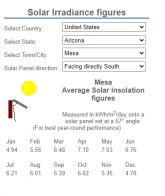Dan3D
New Member
- Joined
- Feb 19, 2021
- Messages
- 3
Hello!!!
I am looking for any and all advice on a 48v solar / battery system for a house with 110 and 240v. I want to be fully off grid if possible. We heat with wood, have a well for water, and going solar is the next step toward a self sufficient country homestead and farm. I would like battery power for 3 to 5 days with minimal or no sun.
I’ve been watching DIY Solar channel for years and waiting for the right time to build my own system. Now is the time!!!
My property has several units on it. The main house and 3 additional tiny home / camper spots use between 2000 kWh and 2500 kWh per month total. We have not even began searching out how to lower our electricity usage yet but we will do that in the future. For now we want to get a system with room to grow so planning for 2000 kWh+ per month is the right move for us.
Simplicity is important to us, we want to build this system on our own. We have an electrician, a carpenter and a mechanic in the family that will help with our install.
An ideal build would be second hand parts, when appropriate to save money, and new equipment when that is the right call, but I do not want to build battery packs from hundreds of cells... purchasing prebuilt packs is best for us.
We have PLENTY of space for installs that take up a lot of room.
I was considering buying Rich Solar panels, I have no ideas yet on which battery systems to use (but I’m willing to get used gear to save cash), and I just recently found out about Growatt 48v 80amp charge controller / inverter. I believe those can be configured in series / parallel for 240v applications.
Please excuse how much of a newbie I am. Although I have watched Will Prowse YouTube channel for yearshave only just recently began researching for our system.
Budget: Depending on how off grid we can be, budget could be well over $20,000. If it’s possible to build it in a way that we can add on to it later, and spend less upfront (like fewer solar panels / batteries at first) we would like that.
We may buy a used Tesla after installing the system. We’re tired of ICE cars.
Suggestions for Panels, Batteries, Wiring and Equipment?
I am looking for any and all advice on a 48v solar / battery system for a house with 110 and 240v. I want to be fully off grid if possible. We heat with wood, have a well for water, and going solar is the next step toward a self sufficient country homestead and farm. I would like battery power for 3 to 5 days with minimal or no sun.
I’ve been watching DIY Solar channel for years and waiting for the right time to build my own system. Now is the time!!!
My property has several units on it. The main house and 3 additional tiny home / camper spots use between 2000 kWh and 2500 kWh per month total. We have not even began searching out how to lower our electricity usage yet but we will do that in the future. For now we want to get a system with room to grow so planning for 2000 kWh+ per month is the right move for us.
Simplicity is important to us, we want to build this system on our own. We have an electrician, a carpenter and a mechanic in the family that will help with our install.
An ideal build would be second hand parts, when appropriate to save money, and new equipment when that is the right call, but I do not want to build battery packs from hundreds of cells... purchasing prebuilt packs is best for us.
We have PLENTY of space for installs that take up a lot of room.
I was considering buying Rich Solar panels, I have no ideas yet on which battery systems to use (but I’m willing to get used gear to save cash), and I just recently found out about Growatt 48v 80amp charge controller / inverter. I believe those can be configured in series / parallel for 240v applications.
Please excuse how much of a newbie I am. Although I have watched Will Prowse YouTube channel for yearshave only just recently began researching for our system.
Budget: Depending on how off grid we can be, budget could be well over $20,000. If it’s possible to build it in a way that we can add on to it later, and spend less upfront (like fewer solar panels / batteries at first) we would like that.
We may buy a used Tesla after installing the system. We’re tired of ICE cars.
Suggestions for Panels, Batteries, Wiring and Equipment?




